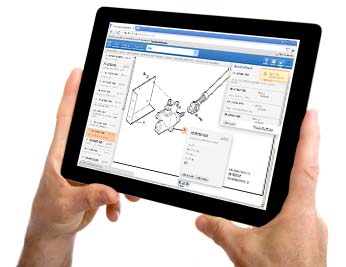Enigma Acquisition Extends PTC’s Push Into Service Lifecycle Management
Latest News
July 25, 2013
Product-centric service has been a mantra for PTC the last couple of years, and the company just initiated another acquisition designed to fill out its Service Lifecycle Management product line and tighten the loop between engineering and service.
As part of PTC’s efforts to stake out new turf beyond CAD and PLM, the company has steadily built out a broad portfolio of products in the SLM space, including modules for service parts planning, field service management, warranty management, technical publishing, returns management, and more. PTC’s strategy is to tap into the growing number of large companies (Eurocopter was a recent win) that are looking to overhaul service processes and build synergies between service groups and engineering to transform service from functioning as a cost center to becoming a steady source of new revenues and profits.
PTC’s latest acquisition in this area is Enigma, which markets software used to deliver product, parts, and service information to engineers and service technicians working in maintenance facilities, field service, or dealer environments. What Enigma provides that PTC currently lacks is a centralized “Service Center” portal for delivering third-party service information—be it CAD files or some other technical document—that was created outside of the PTC platform. Currently, PTC provides capabilities for delivering and publishing service-related information, but the materials had to have been authored and stored in PTC products like Creo Illustrator or Arbortext, notes Dave Duncan, PTC’s vice president, product management for its SLM segment.
“What we’ve been lacking on the Service Center side is an efficient way to deliver third-party created information,” he explains. “There’s a broad range of illustrations created in different products, and we want to be able to deliver that feedback efficiently and that’s where Enigma fits in.” Having one system for services that can provide the latest configuration-specific content and parts information will greatly improve how technicians work as well as promote better quality, product uptime, and ultimately, customer satisfaction, Duncan says.
Specifically, giving technicians access to the right service information at the point of service helps them service equipment more efficiently, yet there is also an upside to the engineering group, Duncan says. As technicians perform their service work on products, they can provide feedback, identifying problem areas that engineering can address in workarounds or subsequent designs, he explains. They can also help identify technical information that is written poorly.
“Typically engineering hasn’t gotten this kind of feedback unless problem reports are logged into the contact center,” says Duncan, explaining that most companies have disjointed, manual processes and maintain multiple systems so there is no tight integration between engineering and service groups. “Now we have automation from CAD into the Service Center tool, and information can be viewed directly at the point of service,” he explains. “In addition, feedback can be entered at the point of service and automatically routed to people throughout the full chain, including both technicians and engineers.”
To see more on how Enigma works, watch the video below.
Subscribe to our FREE magazine, FREE email newsletters or both!
Latest News
About the Author
Beth Stackpole is a contributing editor to Digital Engineering. Send e-mail about this article to [email protected].
Follow DE






